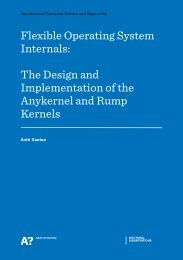Intel SGX Enclave Support in Windows 10 Fall Update (Threshold 2)
1ks6upt
1ks6upt
Create successful ePaper yourself
Turn your PDF publications into a flip-book with our unique Google optimized e-Paper software.
MiF<strong>in</strong>dNext<strong>Enclave</strong>Boundary). For any such memory, it calls MiDbgReadWrite<strong>Enclave</strong> with the source and<br />
dest<strong>in</strong>ation addresses.<br />
Note that two possible operation modes exist: we may be read<strong>in</strong>g FROM an enclave TO regular memory,<br />
or read<strong>in</strong>g FROM regular memory INTO enclave memory. Similarly, one may be writ<strong>in</strong>g INTO regular<br />
memory FROM enclave memory, or INTO enclave memory FROM regular memory.<br />
MiDbgReadWrite<strong>Enclave</strong> correctly deals with both scenarios, and uses either<br />
MiDbgReadWrite<strong>Enclave</strong>Unaligned if the data is not 8-byte aligned, or its own copy<strong>in</strong>g loop for aligned<br />
data.<br />
Obviously, as an optimization, it uses the unaligned function for the header and footer of the buffer,<br />
keep<strong>in</strong>g the bulk aligned, <strong>in</strong>stead of perform<strong>in</strong>g a full unaligned copy. To actually read or write the data,<br />
however, it must use KeDebugRead<strong>Enclave</strong>Memory and/or KeDebugWrite<strong>Enclave</strong>Memory, which should<br />
get us <strong>in</strong>to <strong>SGX</strong> hardware land for the operation.<br />
Indeed, both of these functions will check KeFeatureBits to check for <strong>SGX</strong> availability, and issue the ENCLS<br />
<strong>in</strong>struction with the correct leaf function. Interest<strong>in</strong>gly, however, KeDebugWrite<strong>Enclave</strong>Memory uses the<br />
usual KiEncls function we have seen multiple times (with EDBGWR as a leaf), but<br />
KeDebugRead<strong>Enclave</strong>Memory uses a completely new function called KiEnclsDebugRead. It behaves<br />
identically to KiEncls with one subtle difference – it returns the value of the RBX register, and not RAX as<br />
you’d expect. Let’s take a look at both leaf functions <strong>in</strong> the <strong>Intel</strong> manual:<br />
vs.:<br />
Note how, for the first time, we have an <strong>SGX</strong> leaf function that returns an output parameter! Due to this,<br />
KiEncls would not correctly return the data required, but rather the error code. KiEnclsDebugRead was<br />
created as it is the only way to read the RBX register without resort<strong>in</strong>g to writ<strong>in</strong>g assembly code. Even <strong>in</strong><br />
<strong>SGX</strong>2, EDBGRD is the only function that uses an output parameter, so there’s no overload<strong>in</strong>g of<br />
KiEnclsDebugRead – this function may be renamed if future <strong>SGX</strong>3 <strong>in</strong>structions have outputs also <strong>in</strong> RBX.









